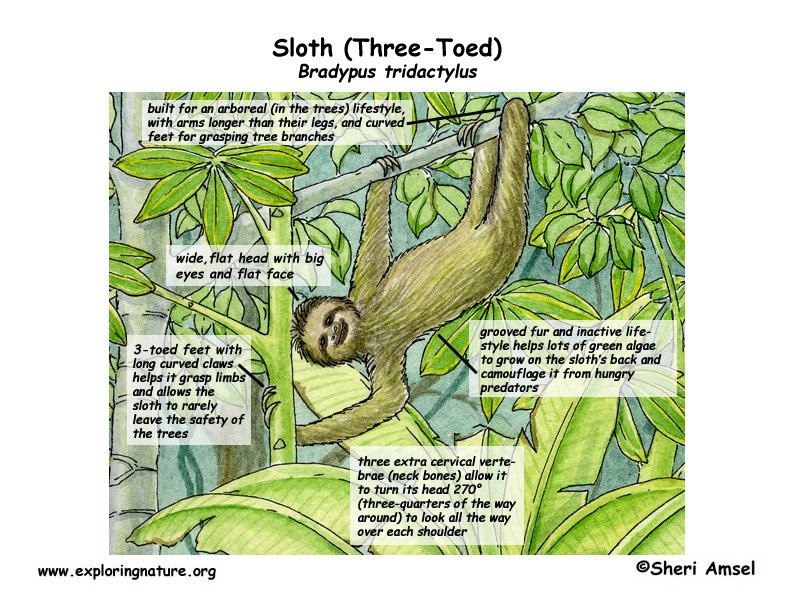

Three-toed sloths are found from Central America (in Honduras) to the middle of South America (Northern Argentina).
They live in tropical rainforests from river valleys to the mountains.
There are many species of three-toed sloth. The most common is the brown-throated, three-toed sloth. They weigh about 10 pounds and are almost tailless, with flat faces, a dark eye mask and invisible ears. The air is so hot and humid that they grow green algae in their shaggy, grooved fur, which helps them blend in (camouflage). Their very slow movement also helps them to hide. They have a complex stomach with many parts to digest the rough leaves they eat and get out the nutrients. It takes a long time for them to digest their food (up to a month!).
Sloths are excellent climbers and swimmers, but cannot walk. They live alone (solitary) except to mate, high up in the trees (arboreal). They rarely ever come to the forest floor because they are built for climbing and cannot escape predators on the ground. They sleep up to 20 hours a day.
They have long, curved claws and hang upside down while they feed on the leaves of the cecropia tree.
Predators include jaguars, harpy eagles and anacondas.
They breed all year. Females are pregnant for 6 months (gestation) and have 1 baby. A sloth baby clings to the belly of its mother for the first six months of its life. Then it begins to move off for a time and feed on its own.
They can live up to 12 years in the wild. They are listed as Lower Risk - least concern.
Kingdom: Animalia
Phylum: Chordata
Subphylum: Vertebrata
Class: Mammalia
Order: Pilosa
Suborder: Folivora
Family: Bradypodidae
Genus: Bradypus
Species: Bradypus tridactylus
When you research information you must cite the reference. Citing for websites is different from citing from books, magazines and periodicals. The style of citing shown here is from the MLA Style Citations (Modern Language Association).
When citing a WEBSITE the general format is as follows.
Author Last Name, First Name(s). "Title: Subtitle of Part of Web Page, if appropriate." Title: Subtitle: Section of Page if appropriate. Sponsoring/Publishing Agency, If Given. Additional significant descriptive information. Date of Electronic Publication or other Date, such as Last Updated. Day Month Year of access < URL >.
Amsel, Sheri. "Sloth (Three-Toed)" Exploring Nature Educational Resource ©2005-2024. December 13, 2024
< http://exploringnature.org/db/view/366 >


